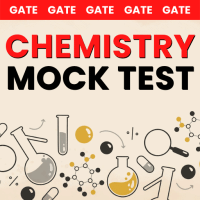Chemistry Exam > Chemistry Questions > In the transformation of oxyhaemoglobin to de...
Start Learning for Free
In the transformation of oxyhaemoglobin to deoxyhaemoglobin:
- a)Fe2+ in the low spin state changes to Fe2+ in the high spin state.
- b)Fe2+ in the low spin state changes to Fe3+ in the low spin state.
- c)Fe2+ in the high spin state changes to Fe2+ in the low spin state.
- d)Fe2+ in the high spin state changes to Fe3+ in the high spin state.
Correct answer is option 'A'. Can you explain this answer?
Most Upvoted Answer
In the transformation of oxyhaemoglobin to deoxyhaemoglobin:a)Fe2+ in ...
Understanding Oxyhaemoglobin and Deoxyhaemoglobin Transformation
The transformation of oxyhaemoglobin to deoxyhaemoglobin involves significant changes in the iron (Fe) state within the haem group.
Oxyhaemoglobin State
- In oxyhaemoglobin, the iron is in the Fe2+ state.
- This Fe2+ is typically in a low spin configuration due to the strong field ligands (oxygen) surrounding it.
Transition to Deoxyhaemoglobin
- Upon the release of oxygen (deoxygenation), the iron undergoes a transition.
- The Fe2+ in the low spin state changes to a high spin state.
Significance of High Spin State
- In the high spin state, the iron has unpaired electrons, which leads to a change in the geometry of the haem group.
- This conformational change is crucial as it allows haemoglobin to release oxygen more effectively.
Other Options Explained
- Option B is incorrect because Fe2+ does not change to Fe3+ in the low spin state; rather, it remains Fe2+.
- Option C is incorrect as it suggests a transition within the same oxidation state (Fe2+) without the influence of oxygen.
- Option D is also incorrect because it implies a change to Fe3+ while in the high spin state, which does not occur in this context.
Conclusion
The correct answer is option A because the transformation from oxyhaemoglobin to deoxyhaemoglobin indeed involves the change of Fe2+ from a low spin state to a high spin state, facilitating the release of oxygen.
The transformation of oxyhaemoglobin to deoxyhaemoglobin involves significant changes in the iron (Fe) state within the haem group.
Oxyhaemoglobin State
- In oxyhaemoglobin, the iron is in the Fe2+ state.
- This Fe2+ is typically in a low spin configuration due to the strong field ligands (oxygen) surrounding it.
Transition to Deoxyhaemoglobin
- Upon the release of oxygen (deoxygenation), the iron undergoes a transition.
- The Fe2+ in the low spin state changes to a high spin state.
Significance of High Spin State
- In the high spin state, the iron has unpaired electrons, which leads to a change in the geometry of the haem group.
- This conformational change is crucial as it allows haemoglobin to release oxygen more effectively.
Other Options Explained
- Option B is incorrect because Fe2+ does not change to Fe3+ in the low spin state; rather, it remains Fe2+.
- Option C is incorrect as it suggests a transition within the same oxidation state (Fe2+) without the influence of oxygen.
- Option D is also incorrect because it implies a change to Fe3+ while in the high spin state, which does not occur in this context.
Conclusion
The correct answer is option A because the transformation from oxyhaemoglobin to deoxyhaemoglobin indeed involves the change of Fe2+ from a low spin state to a high spin state, facilitating the release of oxygen.
Free Test
FREE
| Start Free Test |
Community Answer
In the transformation of oxyhaemoglobin to deoxyhaemoglobin:a)Fe2+ in ...
In hemoglobin, the iron remains in the +2 oxidation state throughout oxygenation and deoxygenation. The key change is in the spin state:
- In oxyhaemoglobin, the Fe²⁺ is in a low spin state (due to strong-field binding of O₂).
- In deoxyhaemoglobin, the Fe²⁺ is in a high spin state (when O₂ is released).

|
Explore Courses for Chemistry exam
|

|
Question Description
In the transformation of oxyhaemoglobin to deoxyhaemoglobin:a)Fe2+ in the low spin state changes to Fe2+ in the high spin state.b)Fe2+ in the low spin state changes to Fe3+ in the low spin state.c)Fe2+ in the high spin state changes to Fe2+ in the low spin state.d)Fe2+ in the high spin state changes to Fe3+ in the high spin state.Correct answer is option 'A'. Can you explain this answer? for Chemistry 2025 is part of Chemistry preparation. The Question and answers have been prepared according to the Chemistry exam syllabus. Information about In the transformation of oxyhaemoglobin to deoxyhaemoglobin:a)Fe2+ in the low spin state changes to Fe2+ in the high spin state.b)Fe2+ in the low spin state changes to Fe3+ in the low spin state.c)Fe2+ in the high spin state changes to Fe2+ in the low spin state.d)Fe2+ in the high spin state changes to Fe3+ in the high spin state.Correct answer is option 'A'. Can you explain this answer? covers all topics & solutions for Chemistry 2025 Exam. Find important definitions, questions, meanings, examples, exercises and tests below for In the transformation of oxyhaemoglobin to deoxyhaemoglobin:a)Fe2+ in the low spin state changes to Fe2+ in the high spin state.b)Fe2+ in the low spin state changes to Fe3+ in the low spin state.c)Fe2+ in the high spin state changes to Fe2+ in the low spin state.d)Fe2+ in the high spin state changes to Fe3+ in the high spin state.Correct answer is option 'A'. Can you explain this answer?.
In the transformation of oxyhaemoglobin to deoxyhaemoglobin:a)Fe2+ in the low spin state changes to Fe2+ in the high spin state.b)Fe2+ in the low spin state changes to Fe3+ in the low spin state.c)Fe2+ in the high spin state changes to Fe2+ in the low spin state.d)Fe2+ in the high spin state changes to Fe3+ in the high spin state.Correct answer is option 'A'. Can you explain this answer? for Chemistry 2025 is part of Chemistry preparation. The Question and answers have been prepared according to the Chemistry exam syllabus. Information about In the transformation of oxyhaemoglobin to deoxyhaemoglobin:a)Fe2+ in the low spin state changes to Fe2+ in the high spin state.b)Fe2+ in the low spin state changes to Fe3+ in the low spin state.c)Fe2+ in the high spin state changes to Fe2+ in the low spin state.d)Fe2+ in the high spin state changes to Fe3+ in the high spin state.Correct answer is option 'A'. Can you explain this answer? covers all topics & solutions for Chemistry 2025 Exam. Find important definitions, questions, meanings, examples, exercises and tests below for In the transformation of oxyhaemoglobin to deoxyhaemoglobin:a)Fe2+ in the low spin state changes to Fe2+ in the high spin state.b)Fe2+ in the low spin state changes to Fe3+ in the low spin state.c)Fe2+ in the high spin state changes to Fe2+ in the low spin state.d)Fe2+ in the high spin state changes to Fe3+ in the high spin state.Correct answer is option 'A'. Can you explain this answer?.
Solutions for In the transformation of oxyhaemoglobin to deoxyhaemoglobin:a)Fe2+ in the low spin state changes to Fe2+ in the high spin state.b)Fe2+ in the low spin state changes to Fe3+ in the low spin state.c)Fe2+ in the high spin state changes to Fe2+ in the low spin state.d)Fe2+ in the high spin state changes to Fe3+ in the high spin state.Correct answer is option 'A'. Can you explain this answer? in English & in Hindi are available as part of our courses for Chemistry.
Download more important topics, notes, lectures and mock test series for Chemistry Exam by signing up for free.
Here you can find the meaning of In the transformation of oxyhaemoglobin to deoxyhaemoglobin:a)Fe2+ in the low spin state changes to Fe2+ in the high spin state.b)Fe2+ in the low spin state changes to Fe3+ in the low spin state.c)Fe2+ in the high spin state changes to Fe2+ in the low spin state.d)Fe2+ in the high spin state changes to Fe3+ in the high spin state.Correct answer is option 'A'. Can you explain this answer? defined & explained in the simplest way possible. Besides giving the explanation of
In the transformation of oxyhaemoglobin to deoxyhaemoglobin:a)Fe2+ in the low spin state changes to Fe2+ in the high spin state.b)Fe2+ in the low spin state changes to Fe3+ in the low spin state.c)Fe2+ in the high spin state changes to Fe2+ in the low spin state.d)Fe2+ in the high spin state changes to Fe3+ in the high spin state.Correct answer is option 'A'. Can you explain this answer?, a detailed solution for In the transformation of oxyhaemoglobin to deoxyhaemoglobin:a)Fe2+ in the low spin state changes to Fe2+ in the high spin state.b)Fe2+ in the low spin state changes to Fe3+ in the low spin state.c)Fe2+ in the high spin state changes to Fe2+ in the low spin state.d)Fe2+ in the high spin state changes to Fe3+ in the high spin state.Correct answer is option 'A'. Can you explain this answer? has been provided alongside types of In the transformation of oxyhaemoglobin to deoxyhaemoglobin:a)Fe2+ in the low spin state changes to Fe2+ in the high spin state.b)Fe2+ in the low spin state changes to Fe3+ in the low spin state.c)Fe2+ in the high spin state changes to Fe2+ in the low spin state.d)Fe2+ in the high spin state changes to Fe3+ in the high spin state.Correct answer is option 'A'. Can you explain this answer? theory, EduRev gives you an
ample number of questions to practice In the transformation of oxyhaemoglobin to deoxyhaemoglobin:a)Fe2+ in the low spin state changes to Fe2+ in the high spin state.b)Fe2+ in the low spin state changes to Fe3+ in the low spin state.c)Fe2+ in the high spin state changes to Fe2+ in the low spin state.d)Fe2+ in the high spin state changes to Fe3+ in the high spin state.Correct answer is option 'A'. Can you explain this answer? tests, examples and also practice Chemistry tests.

|
Explore Courses for Chemistry exam
|

|
Signup for Free!
Signup to see your scores go up within 7 days! Learn & Practice with 1000+ FREE Notes, Videos & Tests.


















